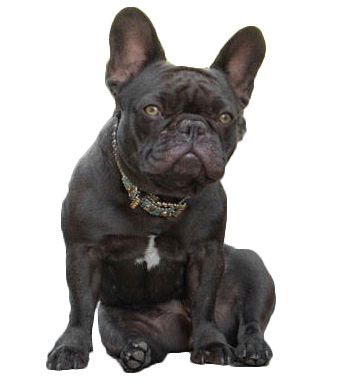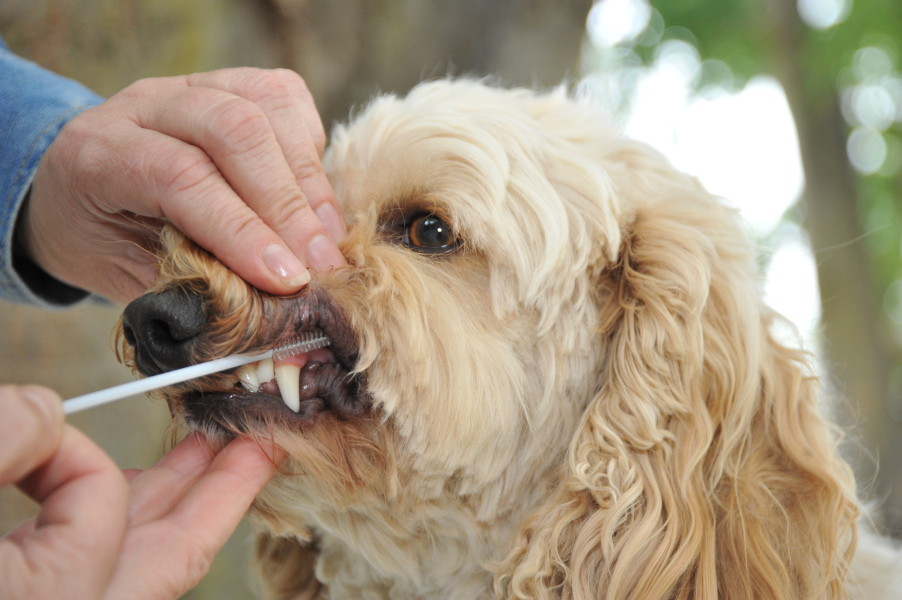Quick Summary

Click here for Price and Turnaround Time
Phenotype: Brown coat color relatively darker than other brown phenotypes in dogs.
Mode of Inheritance: Autosomal recessive
Alleles: N = Non-cocoa, co = Cocoa
Breeds appropriate for testing: French Bulldog
Explanation of Results:
- Dogs with N/N genotype do not have the cocoa variant.
- Dogs with N/co genotype are carriers of cocoa but will not display the cocoa phenotype. If two carriers are mated, 25% of the offspring in the litter are expected to have the cocoa phenotype and another 50% of the offspring are expected to be carriers of cocoa.
- Dogs with co/co genotype may display the cocoa phenotype. Actual appearance is dependent upon the epistatic interaction of other genes involved in coat color.
Sample Collection
Dog DNA tests are carried out using cells brushed from your dog's cheeks and gums. The preferred cytology brushes are sent to you by mail, or you may provide your own brushes. For accepted alternative brushes, click here
We recommend waiting until puppies are at least three weeks old before testing.

Step-By-Step:
- Make sure the dog has not had anything to eat or drink for at least 1 hour prior to collecting sample.
- When swabbing puppies, isolate each puppy from the mother, littermates and any shared toys for 1 hour prior to swabbing. Puppies should not have nursed or eaten for 1 hour prior to collecting sample.
- If collecting samples from more than one dog, make sure to sample one dog at a time and wash your hands before swabbing another dog.
- Label brush sleeve with name or ID of dog to be sampled.
- Open brush sleeve by arrow and remove one brush by its handle.
- Place bristle head between the dog’s gums and cheek and press lightly on the outside of the cheek while rubbing or rotating the brush back and forth for 15 seconds.
- Wave the brush in the air for 20 seconds to air dry.
- Insert brush back into sleeve.
- Repeat steps 5 - 8 for each unused brush in sleeve on a fresh area of cheek and gums. Make sure to use and return all brushes sent by the VGL. In most cases, it will be 3 brushes per dog. If using interdental gum brushes, please note that the VGL requires 4 brushes per dog and only moderate or wide interdental gum brushes are accepted.
- Do not seal brushes in sleeve.
- Place all samples in an envelope and return to the address provided.
ATTENTION:
- Do not collect saliva/drool – the key to obtaining a good sample is getting cheek cells on the swab
- Do not rub swab on the dog’s tongue or teeth – this will result in poor quality sample
- Do not collect a sample from a puppy that has recently nursed – the mother’s genetic material can rub off on the puppy’s mouth and contaminate the sample
There are several known variants that result in the brown phenotype in dogs. All are in tyrosinase related protein 1 (TYRP1). However, these known variants do not account for all brown phenotypes in dogs. The cocoa variant is in another gene and is therefore not another allele of TYRP1. This has important implications for breeding as in some instances the alleles at both genes would need to be considered during mate selection. Specifically, in French Bulldogs, a variant associated with a visually distinct chocolate phenotype was identified in the Hermansky-Pudlak syndrome 3 (HPS3) gene. Dogs with the HPS3 gene variant are visibly darker brown than the phenotypes associated with the previously described TYRP1 brown allele (b).
The canine cocoa variant is a single base change in the HPS3 gene. The single nucleotide change (c.2420G>A) causes a premature protein stop codon in the gene product (p.Trp807*). This results in a loss of nearly 19% of the end of the protein. In humans and mice, changes within this gene have pleiotropic effects, meaning additional effects of the variant are observed beyond a hair/skin pigmentation difference. In humans and mice, additional symptoms include: vision impairment, nystagmus (uncontrolled eye movement), abnormal eye pigmentation, and bleeding due to platelet dysfunction. These additional effects have not been reported in dogs homozygous for the cocoa variant. Therefore, it is unknown if the cocoa variant (co) has pleiotropic effects in dogs.
The variant associated with the cocoa phenotype is inherited in an autosomal recessive fashion. Thus, two copies must be present for the phenotype to be observed and both sexes are affected equally. Data suggest one copy of cocoa (carrier) and one copy of any of the previously described gene variant (carrier) for brown will not result in a brown phenotype. Dogs with two copies of the cocoa variant may be cocoa, however the final phenotype of the dog is dependent on the alleles at other coat color loci.
At this time the interaction of cocoa and the other brown allele is not understood. Therefore, it is not yet possible to predict the phenotype of a dog with two copies of cocoa (co) and two copies of the TYRP1 brown (b).
At this time, it is also unknown if the cocoa variant is found in other dog breeds.
